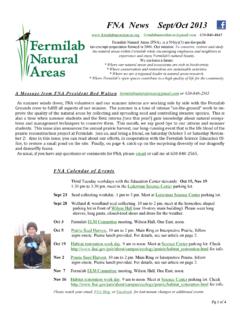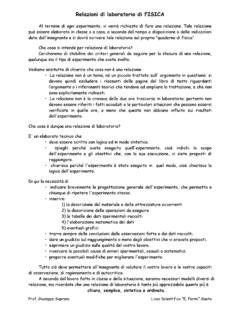Transcription of Fermi National Accelerator Laboratory - VLHC
1 Report for: Estimate of Heavy Civil Underground Construction Costs for a Very Large Hadron Collider in Northern Illinois Prepared for: Fermi National Accelerator Laboratory Batavia, Illinois Prepared by: CNA Consulting Engineers Hatch-Mott-MacDonald September 4, 2001 VLHC Study iTable of Contents List of List of Executive 1 Project 2 Geologic Sources of Geological Galena Prairie du Sandwich Des Plaines Groundwater Rock Condition 3 Assumptions, Construction Conditions and Estimated Heavy Civil Construction Cost Estimate Caverns and Drill & Blast Tunnel Primary Support Requirements Based On Empirical Special Groundwater TBM Type A, Rock Conditions 1,3, and TBM Type B, Rock Conditions 2,5,6,7,8,10, TBM Type C, Rock Conditions 12,13,14, and Site Rock Indirect Price Items not Covered in the Cost Estimate 4 Heavy Civil Underground Construction Figures Appendix A Listing of Project Components Appendix B Notes from Observations and Discussions Appendix C Rock Type Summaries Appendix D TBM Tunnel Assumptions and Cost Estimating Output Appendix E TBM Tunnel Assumptions and Cost Estimating Output (Not Used)VLHC Study iiList of Tables Table 1 Rock Conditions Table 2 Q Ratings for Each Rock Condition Table 3 Rockbolt Spacing & Shotcrete Thickness vs.
2 Rock Table 4 Rock & Tunneling Conditions Table 5 Cost Estimate Summary, Values in Millions of 2001 Table 6 Summary of Underground Construction List of Figures Figure Site Plan Figure North Inclined Ring Rock Conditions Figure North Inclined Ring Lampshade, Rock Conditions Figure North Flat Ring Rock Conditions Figure North Flat Ring Lampshade, Rock Conditions Figure South Inclined Ring Rock Conditions Figure South Inclined Ring Lampshade, Rock Conditions Figure Rockbolt Spacing vs. Q Figure Shotcrete Spacing vs. Q Figure North Inclined Ring Rock Conditions and TBM Types Figure North Flat Ring Rock Conditions and TBM Types Figure South Inclined Ring Rock Conditions and TBM Types Figure Turner Building Cost Index Figure Breakdown Figure North Inclined Ring Rock Conditions, TBM Types, and Schedule Figure North Flat Ring Rock Conditions, TBM Types, and Schedule Figure South Inclined Ring Rock Conditions, TBM Types, and Schedule VLHC Study 1 Executive Summary The team of CNA Consulting Engineers and the Toronto office of Hatch-Mott-MacDonald developed cost estimates for heavy civil underground construction of a staged Very Large Hadron Collider (VLHC) project located tangent to the Tevatron at FermiLab.
3 Three alignment alternatives and two main beam tunnel diameters were included. The cost estimates include heavy civil underground construction that produces stable underground excavations, but excludes outfitting. FermiLab provided detailed project descriptions and so-called lampshades that defined the subsurface geologic formations encountered by the three tunnel alternatives. Ten principal tasks were conducted. A brief summary of each is provided below. 1. Review existing geologic data, using published geologic resources We used the reports listed in the Bibliography to confirm the location and extent of the geologic formations in the study areas. In addition, we formed a conceptual model of the rock conditions present, and identified fourteen rock condition types, which are summarized in the table under item 4 below. 2. Observe pertinent geologic exposures in the field After review of the available and pertinent geologic exposures, this task was limited to an underground tour of the NuMI project construction, and the a surface and underground tour to the Conco Western Stone Quarry in North Aurora, Il.
4 Both visits were very useful in assessing the underground construction conditions for the VLHC components near FermiLab. 3. Quantify all major underground construction components of the VLHC Underground construction components of the VLHC project include the main beamline tunnel, many caverns of varying size and shape, straight and bypass tunnels, portals for the equipment tunnels, injection ramp connections to the existing Tevatron, a magnet installation ramp on the far side from FermiLab, major experiment installation shafts, access shafts, emergency egress and ventilation shafts, site risers, and utility penetrations. Each of these 300-plus components is documented in Appendix A. This report does not include the near-surface structures necessary at the connection from the existing Tevatron to the injection ramps. 4. Categorize anticipated tunneling conditions for major geologic units and contacts between major units For estimating the cost of cavern construction, an NGI Q rating was estimated for each of the fourteen rock conditions identified in Task 1 above.
5 Q values ranged from a minimum of to a maximum of , with cavern rock support and construction conditions depending upon the Q rating. For estimating tunnel construction costs, the fourteen rock conditions were assigned to three tunneling conditions types, as shown in Table 4 on page 12. The finished diameter of the tunnels is either 12 ft or 16 ft, and the TBM s are capable of tunnel drives 4844 meters long, equivalent to the shaft spacing. At end of each drive the TBM could be accessed for reconditioning. TBM Type A, for rock conditions 1, 3, and 9 is used in the best rock conditions where minimal ground support and water control is required. TBM Type B, an open TBM with finger shield, is used for rock conditions 2, 5, 6, 7, 8, 10, and 11 where more ground support and water control is required. TBM Type C, a sealed TBM, is used for rock conditions 12, 13, 14, and the injection ramps where water inflow is great enough to require immediate sealing of the tunnel. The ground support, grouting and final lining methods were selected to produce stable excavations with less than 50 gpm average water inflow per mile of tunnel, including the inflow from caverns and shafts.
6 FermiLab will determine the cost of project outfitting ( electrical, VLHC Study 2 ventilation, cooling, cranes, pumping, lighting, etc.). 5. Develop a bottoms-up estimate for each project component Major cost drivers, the TBM tunnels, shafts and caverns, were estimated by bottoms-up methods. The design concepts for minor items, structures, site risers and utility penetrations, were not sufficiently developed to warrant a bottoms-up approach. 6. Assemble costs from the kit-of-parts to estimate the cost of three tunnel alternatives (North Flat, North Inclined, and South Inclined) and two tunnel diameters (12 ft and 16 ft finished) Completed, see Item 9 below. 7. Provide cost ranges or contingency values appropriate to the understanding of ground conditions and design maturity achieved A 25 percent contingency has been included as a line item in the cost estimate, which is adequate to cover moderate changes in geologic conditions, design, bidding and construction. It is not adequate for major changes like changes in size, length, and number of tunnels, caverns, or shafts.
7 The costs also include percent EDIA costs, including site investigation, professional design services, project management and institutional costs. 8. Estimate heavy civil construction duration for each major project component TBM tunnel construction costs, depending upon the option, are roughly two to eight times shaft costs and four to seven times cavern costs. Hence, TBM tunnels are the major cost drivers and the longest duration elements of VLHC construction. Sequence and duration for TBM drives and TBM contracts were developed for each option. 9. Incorporate cost summaries in an Excel spreadsheet suitable for sensitivity analysis by FermiLab personnel Calculation of the estimated underground heavy civil construction costs for the VLHC project is done in an Excel spreadsheet having more than 15 panes containing the following categories of information: geological information for each alignment option, the station location, size and shape of each shaft, tunnel segment, cavern, riser and other component required for the VLHC, cost information for all types of construction, cost calculations, cost summaries, and quality control and quality assurance calculations.
8 Underground heavy civil construction project costs are estimated to be: Alignment Alternative Tunnel Diameter Estimated Cost (millions 2001 $) North Inclined 12 $2,419 North Inclined 16 $2,713 North Flat 12 $2,550 North Flat 16 $2,936 South Inclined 12 $2,571 South Inclined 16 $2,984 The cost totals reflect the interaction of three principal factors: geologic conditions, ring depth and tunnel diameter. The North Inclined ring has the best geology, while the South Inclined ring has the poorest. The cost advantage of the good geology of the North Inclined ring is substantially offset by the greater shaft costs resulting from ring depth. Shafts for the North Inclined ring are about times more expensive than for the South Inclined ring. TBM tunnel costs are roughly 22 percent more for the 16-ft diameter option. 10. Prepare a written report Contained herein. VLHC Study 3 1 Introduction Project Description Conventional construction of the Very Large Hadron Collider (VLHC) consists of a 233 km tunnel ring, caverns, shafts, risers, and other tunnels and facilities.
9 Chapter 7 of Design Study for a Staged Very Large Hadron Collider, by the VLHC Design Study Group describes the conventional construction. This report addresses the anticipated construction costs for excavation, ground support, water control and lining of the underground, heavy civil portion of the conventional facilities. Costs are estimated for three tunnel alignments and two tunnel diameters. The three alignments, called the North Inclined Ring, North Flat Ring, and South Inclined Ring, are shown on Figure The two tunnel diameters are 12 ft and 16 ft. Tunnel depths for the alignments vary from 180 ft to 700 ft below the ground surface. The tunnels and caverns for all alignments would be constructed in the limestone, dolomite, shale and sandstone bedrock of northeastern Illinois. Shafts would be constructed in the bedrock and overlying glacial soils. Each tunnel section, cavern, shaft, riser, portal, and other associated facility was identified and priced. Appendix A contains a listing of the more than 300 project components.
10 FermiLab personnel determined the cost of outfitting the stable underground excavations studied herein. Limitations The conclusions of this study are limited by several factors: 1. The available geological and geotechnical information and the limited underground construction experience in some formations The Chicago area is widely known for the amount of tunneling done there recently. However, most of this construction is in the Silurian-age formations, with relatively little experience in deeper formations. As a result, there is limited site investigation information and limited underground construction experience in many formations/locations necessary for the VLHC. We believe that our assessments of underground construction conditions is neutral neither unduly optimistic nor pessimistic. Actual conditions may be different than assumed. 2. The level of design development of the project components The existing level of design development is very preliminary. Future design development will lead to improved layouts, but will also identify functions and components that have not been included thus far.







